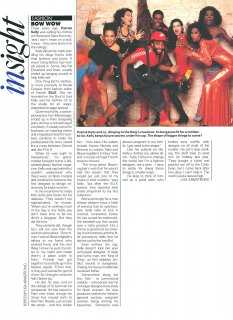

Patrick Kelly's Radical Cheek
In New York, a Designer's Guise and Dolls
By Robin Givhan
Washington Post Staff Writer
Monday, May 31, 2004; Page C01
NEW YORK -- Whenever he mounted a show, Paris-based designer Patrick Kelly would walk onto the runway dressed in the baggy overalls of a furtive street artist and spray-paint a large heart on the stage set. He would always give everyone in his audience a tiny brown doll with molded black hair that could be most accurately described as a pickaninny.
Kelly's mascot was the kind of poorly wrought Negro doll that black children of a certain generation refused to play with and whose parents could scarcely blame them. While the fashion industry was ignoring questions of race, he was embracing the doll as a totem.
Eventually, Kelly would make history, becoming the first American admitted to the Chambre Syndicale, France's prestigious organization of fashion designers. He accomplished that feat in the guise of a charming street urchin with a penchant for racially loaded symbols.
Kelly's clothes exuded whimsy and joy and they arrived at a moment when the fashion industry was welcoming color, ornamentation and extravagance. Kelly showed his first collection in 1985, the same year designer Christian Lacroix introduced le pouf -- the crinoline-lined party dress that overtook every society gala. The television show "Dynasty" was in its heyday. And popular culture was awash in padded shoulders, winged hair, big spenders and conspicuous consumption.
He won notice from the fashion industry with his body-conscious jersey dresses adorned with mismatched buttons, and with his witty expressions of an American tourist's enthusiasm for the City of Light. Kelly was born in Vicksburg, Miss., but his career blossomed in Paris, where in a short time he went from selling his wares on the streets to producing glamorous fashion shows alongside Sonia Rykiel and Yves Saint Laurent.
Kelly's biography as a designer is not unlike those of others who dream of fame and wealth in the garment trade. Like most young designers, Kelly struggled to pay his bills and to buy fabric. But he had celebrity clients such as Bette Davis, Isabella Rossellini and Grace Jones who helped bring his work into the spotlight. Before long he was offered financial backing from Warnaco, a powerful American fashion conglomerate. With that assistance, he hired a staff and pumped his sales volume up to several million dollars.
But Kelly died on New Year's Day 1990, before he could truly take advantage of his financial stability and explore the big plans Warnaco had for him. He was 35. The cause, people said then, was bone marrow disease and a brain tumor. Now it is acknowledged that he died of AIDS.
Any lasting contribution that Kelly made to fashion's vocabulary is dominated by the singular significance of his ethnicity. Kelly was African American and that fact played prominently in his designs, in the way he presented them to the public and in the way he engaged his audience. No other well-known fashion designer has been so inextricably linked to both his race and his culture. And no other designer was so purposeful in exploiting both.
For the first time, Kelly's significance within the fashion industry is examined in an engaging retrospective at the Brooklyn Museum of Art. The exhibition, which runs through Sept. 5 [2004], is one of several that the museum is using to announce its intent to put the interests of its multicultural community before those who would proclaim themselves guardians of high culture. The exhibition portrays Kelly as a subversive kind of race man -- one whose weapons were often big smiles and childlike pranks. With his work he explored racial politics and positioned fashion and style as central to the way in which people are defined.
The pieces on display from Kelly's vast collection of black memorabilia are as important as his garments. Kelly accumulated more than 8,000 examples of advertising, dolls, knickknacks and household products that employed racial stereotypes, caricatures and slurs. His collection includes mammies, pickaninnies, Topsys and golliwogs. Kelly enthusiastically embraced all of the cliches, both good and bad. He was as enraptured of black icons as he was of racist propaganda. The show features Diana Ross and Michael Jackson dolls, and Josephine Baker posters juxtaposed with old boxes of "d*rkie toothpaste."
The designer himself was always seen in outsize overalls -- even if the occasion was formal and before such silhouettes became the uniform of rappers and their fans. He wore a bike messenger's cap, its brim flipped up to reveal "Paris" embroidered on the underside. Kelly acknowledged most every stereotype attributed to Southern blacks. He made fried chicken for his friends, sprinkled his conversations with "honey chile" and made liberal use of aphorisms gleaned from the Good Book and at his grandmother's knee.
One could argue that as an expatriate in Paris, Kelly profited from enduring and damaging stereotypes while blacks back home suffered them. He played the quaint Southern naif. And in that analysis he could be one of the mercenary race traitors in "Bamboozled," Spike Lee's troubled film about popular culture and racial prejudices.
But Kelly's legacy bears few indications of self-doubt, anger or hatred -- self- or otherwise. Instead, it is relentlessly, ruthlessly joyful, a spirit that is captured in the exhibition. By embodying the stereotypes, Kelly sought to deflate them. He was a cheerful and charming radical who handed out his tiny black plastic baby dolls -- their lips dyed bright red -- to anyone he might meet.
"He would purchase these little black dolls made out of plastic -- 600 a month. People would volunteer and with a glue gun attach pins to the back. He would never leave without stuffing his pockets with them," says Bjorn Amelan, Kelly's companion and business partner.
article from http://www.washingtonpost.com/wp-dyn/articles/A3561-2004May30.html
Last edited by a moderator:

















